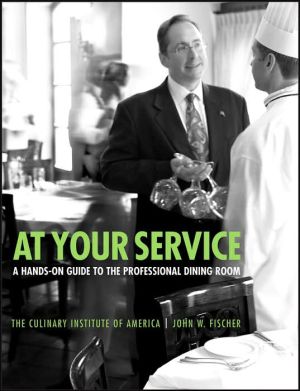At Your Service: A Hands-on Guide to the Professional Dining Room
"The nation's most influential training school for professional cooks."\ –Time magazine\ The essential guide to the exemplary service and hospitality that build customer loyalty...and restaurant reputations\ In today's competitive restaurant environment, culinary excellence is not enough. Dining establishments must offer the kind of service that sets them apart. From the renowned Culinary Institute of America, At Your Service is the comprehensive, contemporary guide to help professionals...
Search in google:
"The nation's most influential training school for professional cooks." —Time magazine The essential guide to the exemplary service and hospitality that build customer loyalty . . . and restaurant reputations In today's competitive restaurant environment, culinary excellence is not enough. Dining establishments must offer the kind of service that sets them apart. From the renowned Culinary Institute of America, At Your Service is the comprehensive, contemporary guide to help professionals learn the ins and outs of running a successful front-of-the-house operation: taking reservations and greeting guests, basic service, table-side service, beverage service, and money handling. The book includes: Guidelines to enhance service in a variety of settings, from formal French establishments to casual American restaurants Sidebars and real-life anecdotes from industry professionals to reinforce the principles of good service Effective ways to address staffing challenges Ideas to enhance the relationship between the front and back of the house Sixty-four photographs of dining room service and techniques Founded in 1946, THE CULINARY INSTITUTE OF AMERICA is an independent, not-for-profit college offering bachelor's and associate degrees in culinary arts and baking and pastry arts. Courses for foodservice professionals are offered at the college's main campus in Hyde Park, New York, and at its additional campus for continuing education, The Culinary Institute of America at Greystone, in St. Helena, California.
At Your Service\ \ John Wiley & Sons\ ISBN: 0-7645-5747-5 \ \ \ Chapter One\ the BASICS of HOSPITALITY and SERVICE\ SETTING: A formal French restaurant\ THE PLAYERS: Four ladies from New York on a visit; the maitre d'hotel The dinner guests had thoroughly enjoyed the food and wine and were pleased by the service, but they'd already missed the next-to-last train from Poughkeepsie to Manhattan, and the departure time of the last train was drawing close. As they paid their check, the maitre d' phoned a local cab company to take the ladies to the train station. They left in a rush of thanks and well-wishing, hoping to catch their train.\ The foursome had been the last customers for the evening, and the maitre d' left soon thereafter. Pulling out of the parking lot, he saw the ladies still waiting and knew that if the cab didn't arrive that instant, they would miss the train. But no cab could be seen down the road. There was only one way to get the ladies to the train station on time, and so he squeezed them all into his rather small car and made a beeline for the station. The car was not built to accommodate that number of people, and each bump they hit brought a gale of laughter and references to who had eaten the most dessert. At the station, the guests scrambled out of the car, calling their thanks as they dashed into the nearest car of the train. He didn't hear from them again. He didn't need to.\ Admittedly, this was a rather extreme circumstance, and one that is not likely to happen on a regular basis. However, it is possible to apply the same principle of hospitality almost every day. For example, guests are sometimes in a hurry to get to the theater and don't have time for dessert. I have known waiters who would pack up some cookies or petit fours and hand them to the guests as they rushed out the door. It's a simple, thoughtful action that takes little effort but shows true hospitality.\ WHAT IS HOSPITALITY?\ BECAUSE I TEACH HOSPITALITY, I spend a lot of time in class discussing the concept. The H-word is used a lot at the school-perhaps a bit too much: "We're in the hospitality business"; "Let's show the guests some of our famous hospitality." Despite such constant use of the term, students often arrive not knowing exactly what it means. And it's not all that easy to pin down: I can teach students the smallest details of fine table service, but the concept of hospitality extends beyond the mastery of such professional skills.\ To help bring the concept to life, I begin with an example that draws upon the students' own memories and emotions. I ask them to recall an extra-special gathering at their home-perhaps a holiday meal, friends from far away arriving for a joyous celebration, or Mom or Dad's boss coming over for dinner. Most of the students have experienced such an occasion. Then I ask them what their house was like for the couple of days beforehand. They recount stories of long shopping lists and the back of the car filled with groceries. Cleaning took on a new dimension, perhaps requiring the use of nontraditional implements such as toothbrushes and Q-Tips, and the scent of Lemon Pledge hung in the air. Martial law reigned in the kitchen as parents prepared dishes that weren't run-of-the-mill dinner fare. Then, the main event: taking guests' coats at the door, remembering what everyone wanted to drink, carefully carving the turkey and arranging the meat on an enormous platter, and each member of the family hustling around the house to make sure that none of the guests wanted for anything. Every activity pertained to making the guests feel comfortable and welcome. Recalling this, most students immediately understand, on an emotional level, what hospitality is all about.\ The joy of planning and executing a terrific party, of being a great host and participating in your guests' delight, is one of the great pleasures in life. When students ask me what draws people into the restaurant business, this is what I tell them. And this, in fact, is the reason I teach hospitality for a living. What I learned in my family about treating guests well-especially from my mother, who is a master of the dinner party-is what spurred me onto this career path.\ At its best, when everything comes together, running a dining room feels like you're giving the best dinner party ever. Trained cooks and a great chef send out delicious food; beautiful surroundings and the right music coax guests into an expansive mood; a professional, highly trained staff brings the guests whatever they need, ideally before they know they need it. In the dining room, we are presented with the opportunity to bring complete strangers into our warm, welcoming space and make them feel part of our family, so that they want to return over and over again.\ So this is hospitality-inviting guests in and ensuring that we have done everything within our control to make them happy. This task is difficult enough for any person to carry out at home two or three times a year. The kicker is that we do it for a living every day. We are in the hospitality business. And making hospitality a business involves identifying those aspects of a fabulous special occasion at home that can and should be reproduced in the restaurant, and then reliably performing those actions whenever necessary.\ HOUSE STYLE\ EACH OF US HAS OUR OWN STYLE when it comes to taking care of guests in our homes, and the same is true of restaurants. One factor that goes into determining a restaurant's house style is the type of establishment: fine dining, with luxurious surroundings and a leisurely pace; bistro or trattoria, which encompasses a wide range of restaurants, all with a simple, cozy feel; or family-style or casual, which may range from diner to theme restaurant and beyond.\ Another factor is the restaurant owner's personality. Just as some people may be huggers and others air-kissers, some restaurant owners prefer that the house style be a formal one, while others embrace a more casual feel. For instance, in a family-style Italian restaurant it might be appropriate for the owner or waiter to warmly greet a guest by his or her first name. However, in a high-end French restaurant, it is likely that the guest will be greeted more formally, with the maitre d' or owner using a courtesy title and the guest's surname. There are, of course, many possible variations along this spectrum-for example, some formal places are more relaxed than others while still maintaining an elegant, polished feel.\ A third element is the restaurant's intended clientele. Just as someone giving a dinner party at home would tailor the event to the guests-perhaps a catered white-glove dinner for members of a charity organization's board of directors, a taco buffet for families from the neighborhood-a restaurant proprietor has to decide what kind of establishment he or she wants to run and establish a style that matches. I've worked in formal restaurants where any waiter who touched his or her nose while in the dining room would be polishing silverware for a week. Conversely, I've also worked in a family-run Italian restaurant where there was lots of hugging and kissing. In each case, the house style was both appropriate to the guests and a reflection of the owner's personal style.\ Not to be left out, the style of your restaurant can also determine which service model to use.\ THE HISTORY OF SERVICE\ BEFORE DISCUSSING the different types of service, it might help to know how service of food has evolved through the ages.\ THE EARLY STAGES\ Some of the earliest writings on serving food describe dining in Greek high society. There weren't many public dining places, so entertaining took place mostly in the home. Rather small rooms with couches for the guests were used for the purpose.\ Food was brought out in large dishes from which the guests served themselves, tossing shells and bones onto a small table in front of them. As the courses progressed, the tables would be removed and quickly replaced with clean tables.\ The Romans borrowed much from Greek culture and developed more of their own. Roman food was much more complex, with many more spices and seasonings. Exotic spices were, of course, a sign of affluence because most of them came from the Far East. Diners sat in places determined by status-places of honor being reserved for the host and important guests. The room they ate in was called a triclinium, with three benches in a U-shape. Each couch held three reclined guests who leaned on their left sides, leaving their right hand free to grasp food. Again, servants brought out food in a series of courses. The reclining thing sounds comfortable, but it probably wasn't too good for the digestion.\ THE MIDDLE AGES AND THE RENAISSANCE\ Anglo-Saxon banquets during medieval times were rather large affairs held in the main hall of a castle. The tables were in a large U, with the host and prominent guests seated at the head table. The tables were covered with a white cloth, and the salt cellar was placed in front of the most important person at the table-salt was highly valuable then. You could tell how important you were by how close the salt was to your place at the table. The food was served from large bowls on the table; guests brought their own knives for cutting food into serving pieces and would often share a plate among three or four diners. French banquets differed in that the tablecloth hung over the sides and was used by the diners to wipe off their hands and faces. How civilized!\ French banquets became more and more lavish, with huge displays of food and decoration. Toward the end of the eighteenth century, only the aristocracy was eating this way ... but not for long. The French Revolution in 1789 toppled the French monarchy and nobility, and left a lot of chefs unemployed. This was a major factor in the growth of restaurants-the chefs had to ply their trade as businesspeople. Restaurants had been in existence before the revolution, but the growth of the middle class created more demand for them.\ As the fourteenth century ended, food service was becoming the subject of study and began to be respected. Taillevent (Guillaume Tirel) was cook to both Charles V and Charles VI, and he wrote the book Le Viander, which codified the cooking of the day.\ However, the first signs of fine dining appeared in the sixteenth century in the court of the Medici family of Florence, Italy. The dissemination of fine dining habits began when Caterina de'Medici (1519-1589) married King Henri II of France and brought a phalanx of trained cooks, chefs, servants, and sommeliers with her. She also introduced the habits of fine dining to the French. Her cousin Marie de' Medici, as wife to Henri IV, took over where Caterina had left off. One of the most famous chefs of all time, Francois La Varenne, received his training in the kitchen of Henri IV, and he wrote a book in 1651 that looked to the future, Le Cuisinier Francois (Francois the Cook).\ TYPES OF SERVICE\ AMERICAN SERVICE, FRENCH SERVICE, RUSSIAN SERVICE, MONGOLIAN SERVICE: only one of them requires the use of yak pelts. The other three types of service (and a few additional ones) are used in professional dining rooms these days. The style of service that you choose depends on two things: the demeanor of the dining room and the demands of the situation. A formal restaurant is a more likely place for French service to be used, and having twelve people at a banquet table would be a good time to break out the platters for some Russian or butler service. While the basic tenets of each style are pretty well defined, there is some blurring of the lines between them-and some disagreement about which is which. In fact, while researching this subject I found Russian and French service described in the exact same words in the same book!\ Below you will find some relatively simple explanations of the styles along with some advantages and disadvantages of each.\ As the world moved into the Industrial Revolution in the 1800s, the world of food service moved quickly to fulfill the needs of workers. Factories drew large numbers of workers who had to be fed. The tight mealtime schedules caused a need for fast, efficient service. Counter service became popular, and the first Horn & Hardart Automat opened in Philadelphia in 1902. Fine dining wasn't dead, though. Delmonico's (opened in 1837) had a 100-page menu with 370 dishes and catered to New York's elite. In less than a century, fine food service went from being the province of the wealthy and powerful to being much more egalitarian and democratic. As Americans continue to seek out sources of prepared food, food service will become increasingly part of their lives.\ AMERICAN SERVICE\ This is a very popular style of service used not just in America but in many other countries. Its hallmark is efficiency, and thus it tends to be used in more casual and high-volume restaurants. Its efficiency has, though, attracted many purveyors of fine dining and led to its use in many formal restaurants.\ In American service, the food is cooked and plated in the kitchen. The waiter delivers the food, one plate at a time, to the guests at the table, ladies first. These days, most service professionals agree that the guest should be served from the right side, with the waiter's right hand. Clearing of plates is also performed with the right hand from the right side. This goes against my earlier training, in which I was taught to serve from the left with the left, and clear from the right with the right. Whichever one you choose, train the staff to do so consistently. When the right hand is used for serving or clearing, the waiter should move around the table in a clockwise direction; it is more efficient (and safer) because the waiter is, by definition, walking forward rather than backing up. Conversely, any task performed with the left hand should lead the waiter around the table in a counterclockwise direction.\ In most American restaurants, the service brigade consists of waiters, runners, and bussers. The waiter interacts directly with the guests and manages his or her station. Runners bring food from the kitchen into the dining room, and bussers clear and reset tables, pour water, refill bread, and assist the runner. Rather than three-person teams, most restaurants have more waiters than runners, and more runners than bussers. This is because the runners' and bussers' jobs are more general and can cover more territory in the restaurant-their work isn't as guest-specific.\ (Continues...)\ \ \ \ \ Excerpted from At Your Service Excerpted by permission.\ All rights reserved. No part of this excerpt may be reproduced or reprinted without permission in writing from the publisher.\ Excerpts are provided by Dial-A-Book Inc. solely for the personal use of visitors to this web site. \ \
Ch. 1The basics of hospitality and service1Ch. 2The relationship between the front and the back of the house21Ch. 3The front door35Ch. 4Preparation for service57Ch. 5Serving guests : the main event75Ch. 6Tableside cooking107Ch. 7Beverage service125Ch. 8Staffing challenges157Ch. 9Taking care of business171Ch. 10It's going to happen : handling emergencies189








